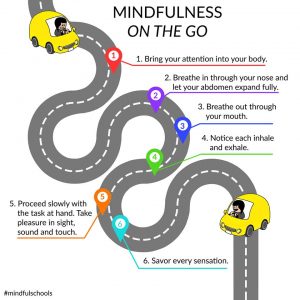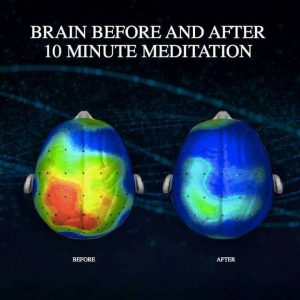Mindfulness
Mindfulness is paying attention in a particular way on purpose, in the present moment, and without judgment." Jon Kabat Zinn, founder of Mindfulness-Based Stress Reduction (MSBR)
BRIEF SUMMARY
“Mindfulness is paying attention in a particular way on purpose, in the present moment, and without judgment.” Jon Kabat Zinn, founder of Mindfulness-Based Stress Reduction (MSBR)
KEY POINTS
- Mindfulness is accepting our present thoughts, feelings, and body sensations without judgment.
- Mindfulness can result in both physical and mental health benefits.
SHARED WISDOM
- Mindful Moment Room presentation. This is a free webinar. It is a two part series. When you register for it, you will receive an email with links to Part 1 and Part 2: https://keepindianalearning.org/events/mindful-moment-room-implementation-series/
- My school has had a Mindful Moment Room (MMR) for 4 years. We have had great success with helping students with this intervention. We use it as a Tier 1 intervention for students who need help to regulate in the moment. We also use it as a Tier II intervention in which students who need to practice mindfulness practices in order to improve their coping skills are scheduled for regular times in the MMR. We track data on how successful the room is in preventing office referrals and suspensions. We are seeing success rates of about 95% of students who visit the MMR on a particular day are not receiving an office referral and about 98% of our students who visit the MMR are not receiving a suspension on the same day. We have seen an overall decline in the number of office visits and suspensions since we have implemented our MMR. he MMR is just one part of what we do to support students. Teachers also lead 3 mindfulness practices each day. We have also implemented morning meetings, closing circles, and other trauma-informed practices. Channel 8 featured our MMR the first year that we opened. Here is the link to the story: https://www.wishtv.com/news/beech-grove-city-schools-use-new-approach-to-help-students-social-emotional-needs/. From Trudi Wolfe, Central Elementary, Beech Grove
- Stop, breath, think by My Life is a free app for breathing and guided mindfulness meditations.
- Q: I’m looking to replenish supplies/materials in my calming room space. What things do you use? What do your students enjoy/find helpful?
- A: We have sound machines and headphones and some adult coloring books with colored pencils. Lots of squishy toys, calming lotion from Bath and Body works, peppermint candy and gum, and some water bottles with the liquid beads, glue and glitter.
- A: We do have a mindfulness room and the items the kids like the most are Theraputty and the sand tray. We also have several of those sequin pillows they can play with. We got a large coloring tablecloth to hang on the wall that they can color in as well. I think the sound machine is maybe the most important part of creating the calming environment, however, especially with all the noise that comes with being in a middle school.
- A: For the mindfulness room, we have a lot of success with squishies, aromatherapy putty, DNA stress balls, sand/zen garden, oil diffuser, and reversible sequins pillows. We also have a colorable sheet that we hung up on the wall (I think it’s advertised as a colorable tablecloth). Students use colored pencils to color it in.
- A: Our students are really loving the wobble chairs. Each of our classes has a “calm corner.” Some have teepees with a small basket of books and a big padded pillow (only one person allowed). Weighted lap pads, mesh squishy balls (they don’t always last long), sand trays (moon sand is easier to clean, and labyrinths are our most used items. The little kids love simple puzzles and playdough.
- A: Yoga mats and a bluetooth speaker for relaxing music.
- A: The counselors throughout our cooperation have been testing out a new product called Cahhlm Disc. It was created by a teacher because he saw a need and went for it. The counselors here love them and the students have been giving all great feedback. I work in a high school setting so calming tools can seem childish. This is very discrete and simple in design. Our JH counselor said she has been using it daily for her students. Here is a link to give you more detail about the product and what it does: www.CahhlmDisc.com. I would recommend getting some for your space and to keep in your office. The discs really do come in handy and are super easy to use!
- Quick Mindfulness exercises (from Counselor Talk, August 2018)
- I have purchased Yoga for Classrooms. It costs $30-totally worth it! It is a series of chair and standing yoga poses that take 1-2 minutes to teach. I begin every lesson with one of these and the students (and teachers!) love it! I would also recommend getting a Tibetan singing bowl. There are youtube videos to teach yourself how to use it and it is another tool that the students enjoy.
- I have found the book, Calm Classroom, by Jai and Joy Luster to be a great resource.
I have also done a lot of work teaching our teachers to do mindfulness practices. This way it happens every day, sometimes multiple times a day. One of our objectives for our Lilly Grant is to have each teacher have a copy of Calm Classroom.We also a Mindful Moment Room to help children calm down, and teachers have a calming areas in their classrooms.A lot of our mindfulness practices also come from the Holistic Life Foundation in Baltimore. Here is a link: https://hlfinc.org/Another resource is mindyeti.com. There are free videos to use.We have done a lot with mindfulness practices at our school, and it has spread to the other elementary schools on our district (Beech Grove)
- I give this Grounding Exercise to students who struggle with anxiety and have them tape it to the inside of their agenda books. During College GO! Week, I do a meditation session with seniors. I also send out the Grounding Exercise during Suicide Prevention Week to all students and parents.
- From Hendry Park Elementary School principal, Lisa Bauer, on a mindfulness room [Counselor Talk, Sept. 2017]:
“We hired an instructional assistant to supervise the In School Support Room. We have forms that the teacher and IA fills out with the behaviors the student is displaying, previous actions taken by the teacher, when the teacher will return for the student, calming strategies used, academic work completed and the time in/time out. This data is charted and a copy sent home with parents to keep them informed. Sometimes students need to take a break and get away from all the stimulation in the classroom. They may be in the room for 10 minutes to an hour. Master Shepherd (a master Tae Kwon Do instructor) works with them to regain self control, self respect, and respect for others. Sometimes they play checkers and talk about moves made and relate it to the incident at hand. We have a small tent in the room that some students like to go into and read or chill. We have classical music playing and a relaxing scent in the difusser. The classroom has 3 study carols and 6 desks/chairs. Our Emotionally Disabled classes go daily to take movement breaks as Master Shepherd leads them through a Tai Chi workout. Master Shepherd has a hand held radio that teachers use to call him to come to their room to escort a student. If he has multiple students, I will escort the student or cover the room. All of our IAs are CPI certified…Our staff met on several occasions and discussed the purpose of this student resource room and a quick to mark documentation form…The intent is to restore a positive teaching and learning environment and be an alternate location for disruptive students to calm down and reflect on the inappropriate behavior.”
- I would preface any mindfulness work that is has nothing to do with religion…just to be safe.
- I use Yoga for Classrooms at the start of each of my classroom lessons. The kids (and teachers) really enjoy it and I find when working with individuals it is easier because they all have a basic understanding of body posture and deep breathing. We as a district are getting ready to put a mindful space in each of our buildings to help students self-regulate and I think having this basic skill will allow our students to use the space more effectively. (Counselor Talk, Sept. 2017)
- This is my first year using meditation with students. I’ve been doing lessons with the AP students first in the hope that I’ll eventually make it to the lower grades and the gen ed students. I do the lessons in a classroom for 5 consecutive days (1 week). I ask the teachers if they want to do the exercise at the beginning or the end of their class. I spend about 8 minutes on Monday explaining meditation to the students (their perceptions of it, using it as a coping skill, explaining the breathing as “smell the flowers, blow out the candles”, etc.) and doing the exercise. (I also mention that they may feel silly doing the exercise but that’s okay! It’s their first time and they can try again by re-focusing on their breath.) On Tues-Fri, it takes about 3 minutes and we just do the meditation exercise. On Friday, I’ll ask them what they thought (What did they think of it, what changes did they feel, etc). The two teachers who have volunteered their class have really liked it (the teachers have participated too) and one class has even asked to do it every day for the rest of the year – very encouraging! (Counselor Talk, Sept. 2017)
- I kept my time in the room short in an attempt to value the teachers’ instructional time, to show the difference 3 minutes can make, and keep the kids engaged. (Counselor Talk, Sept. 2017)
- We do brief mindfulness activities before ISTEP, but that’s it. Some teachers use mindfulness in their classes. ISTEP teachers and students really like the mindfulness activities prior to ISTEP. (Counselor Talk, Sept. 2017)
RESOURCES
- Sit Down & Reflect: Meditation for Beginners: This resource was shared with Counselor1Stop by Bayerton Area Girl Scout Troop 42. Thank you, Kelly & Troop!
- IYI (Indiana Youth Institute) has titles available from its library focused on mindfulness as it relates to specific issues like anxiety, anger, depression, stress, and/or trauma. For more related topics, try searching the catalog for mindful* (using the asterisk will get you mindful, mindfulness, etc.). The IYI library can be accessed here [gdrts_stars_rating type=”counselor1stop.resources” id= 13106 ]
- Here is the link I use. It’s 3 minutes long:
(Counselor Talk, Sept. 2017) [gdrts_stars_rating type=”counselor1stop.resources” id= 13107 ]
- Calm.com (schools) [gdrts_stars_rating type=”counselor1stop.resources” id= 13108 ]
- Calm.com [gdrts_stars_rating type=”counselor1stop.resources” id= 13109 ]
- Middle School Level: Mindfulness with Middles: Teaching Teens to Practice Mindfulness
- Book, Sitting like a Frog by Eline Snel (available on Amazon.com)
- Book, Brain Breaks for the Classroom by Scholastic (available on Amazon.com)
- “60 Brain Breaks Cards” by Rachel Lynette (available on Teachers Pay Teachers)
- “Calm Down Kit on the Go” by The Autism Adventures of Room 83 (available on Teachers Pay Teachers)
- Article, “How the Brain Changes when You Meditate” by Jennifer Wolkin. https://www.mindful.org/how-the-brain-changes-when-you-meditate/
- Article, “Can Teaching Kids Mindfulness Replace Discipline?” by Sandi Schwartz: https://www.mother.ly/parenting/can-teaching-kids-mindfulness-replace-discipline
- Holistic Life Foundation: https://hlfinc.org Programs in Baltimore Schools that have reduced suspensions to zero in schools with a Mindful Moment Room.
- Website: https://mindyeti.com Several free resources for mindfulness practices. There is an option to pay a fee to access more resources. There is also an option to buy a license for a whole school.
- Article “What Is Mindfulness?” https://greatergood.berkeley.edu/topic/mindfulness/definition
- Rainbow Breaths on youtube:
- GoNoodle.com – mindfulness and motion videos (free)
- Go Noodle has a lot of mindfulness resources in addition to rainbow breath: Melting, Bring It Down (available on youtube.com)
- Use an expanding ball (Hoberman sphere) to help students learn how to take deep breaths. Available on Amazon.com
- Use essential oils for calming. Lavender and orange are very good for calming. Use on cotton ball in a Ziplock for individual use or in a diffuser for whole-room use. You can also use lavender baby lotion for students to use on hands and even for a touch on their tip of nose for smelling.
- Hot chocolate or chocolate chip cookie breath: Hold hands as though holding a cup of hot chocolate or a warm chocolate chip cookie. Take a deep breath to smell the hot chocolate or cookie. Then exhale to cool the hot chocolate or cookie. Continue until at least three deep breaths are taken. Then use imagination to drink the hot chocolate or eat the cookie!
- Article: “Mindfulness in the Classroom” by Juliann Garey. https://childmind.org/article/mindfulness-in-the-classroom/
- Article “Breathing Exercises” by Liz Bragdon. https://move-with-me.com/self-regulation/4-breathing-exercises-for-kids-to-empower-calm-and-self-regulate/
- Article: “10 Ways to Teach Mindfulness to Students” by Sarah Rudell Beach. https://leftbrainbuddha.com/10-ways-teach-mindfulness-to-kids/
- Video: “Mind in a Jar”:
- “Feeling the Breath Mouse” video:https://www.youtube.com/watch?v=T3c0ihnWWbk&t=1s
- video: “Mind the Bump–Mindfulness and How the Brain Works”https://www.youtube.com/watch?v=aNCB1MZDgQA
- Article: “Does Mindfulness Really Work in Schools?” by Emily Deruy: https://www.theatlantic.com/education/archive/2016/05/testing-mindfulness-in-the-early-years/483749/
- Article: “Classroom Mindfulness in Real Life: A Portrait” by Jey Ehrenhalt: https://www.tolerance.org/magazine/classroom-mindfulness-in-real-life-a-portrait?utm_source=Teaching+Tolerance&utm_campaign=b40d1dfbc2-Newsletter%3A+When+a+First-Grader+Is+Called+a+Racist&utm_medium=email&utm_term=0_a8cea027c3-b40d1dfbc2-83292611
- Article: “Your Breath Is your Brain’s Remote Control” by Crystal Goh: https://www.mindful.org/breath-brains-remote-control/
- Article: “Mindfulness in Schools–Relaxation and Awareness”by incompassinged: http://www.incompassinged.com/2017/10/13/mindfulness-in-schools-relaxation-and-awareness/
- Article: “Does Mindfulness Meditation Really Make you Kinder?” by Jill Suttie: https://www.mindful.org/does-mindfulness-meditation-really-make-you-kinder/?utm_source=Mindful+Newsletter&utm_campaign=8c5232a067-EMAIL_CAMPAIGN_2018_07_30_01_43&utm_medium=email&utm_term=0_b4e0293689-8c5232a067-44666187&mc_cid=8c5232a067&mc_eid=c57bf1ca01
- Article: “How to Avoid a Poorly Designed School Mindfulness Program” by Jamie Bristow: https://www.mindful.org/4-signs-poorly-designed-school-mindfulness-programs/?utm_source=Mindful+Newsletter&utm_campaign=87f9399bca-EMAIL_CAMPAIGN_2018_08_27_01_40&utm_medium=email&utm_term=0_b4e0293689-87f9399bca-44666187&mc_cid=87f9399bca&mc_eid=c57bf1ca01
- Video: “Just Breathe”:
- Video: “Jewel Shares Mindfulness Practice”: https://www.mindful.org/singer-jewel-shares-mindfulness-practices/
- Video: “One Minute Breathing Exercise”:
- Article: “Mindfulness in Education” by Caren OstenGerszberg: https://www.mindful.org/mindfulness-in-education/
- Article: “Why Mindfulness Belongs in the Classroom.” by Michelle Kinder: https://www.mindful.org/why-mindfulness-belongs-in-the-classroom/
- Article: “A Glimpse at a Mindfulness Class for Children” by Katie Grimesey: https://www.mindful.org/a-glimpse-at-a-mindfulness-class-for-children/
- Article: “Raising Baltimore” by Cartsen Knox (Holistic Life Program in Baltimore schools): https://www.mindful.org/raising-baltimore/
- Book: Mindfulness Skills for Kids and Teens by Debra Durdick (available on amazon.com)
- Video for very young children about how to take deep breaths: “Sesame Street: Common and Colbie Caillat: Belly Breathe with Elmo”:
- Article: “Meditation Rekindles Students’ Energy, Focus” by Lauren Barack: https://www.educationdive.com/news/meditation-rekindles-students-energy-focus/543930/
- Website: Kate Beddow. Mindfulness resources and sign up for free newsletter. https://www.katebeddow.co.uk/ Also, find her on Facebook. Sometimes there are free lessons on Facebook.
- Article: “Students Learn that Active Bodies Lead to Active Minds” by Anna Oberthur: https://www.edutopia.org/active-bodies-active-minds-students-move-to-learn
- Article: “Energy and Calm: Brain Breaks and Focused-Attention Practices” by Dr. Lori Desautles: https://www.edutopia.org/blog/brain-breaks-focused-attention-practices-lori-desautels
- Article: “Dance Makes Learning Memorable” by Laurel Zahrobsky and Ralph Covino: http://www.ascd.org/ascd-express/vol14/num14/dance-makes-learning-memorable.aspx?utm_source=ascdexpress&utm_medium=email&utm_campaign=Express%2014-14
- Article: “How Making Time for Mindfulness Helps Students” by Grace Tatter: https://www.kqed.org/mindshift/53110/how-making-time-for-mindfulness-helps-students
- Article: “Portland Students Make a Case of Baskets” by Kate Irish Collins: http://www.theforecaster.net/baskets-help-deering-students-de-stress/
- Article: “Researchers Study How Mindfulness Mediation Affects Students” by Devin Scillian: https://www.clickondetroit.com/news/national/researchers-study-how-mindfulness-meditation-affects-students
- Article: “Calming your Anxious Mind through Rhythmic Movement” by Joanna Ciolek: https://www.acesconnection.com/blog/calming-your-anxious-mind-through-rhythmic-movement
- Article: “Does Mindfulness Actually Work in Schools?” by Emily Duruy: https://www.theatlantic.com/education/archive/2016/05/testing-mindfulness-in-the-early-years/483749/
- Article: “Mindfulness Activities for Children and Teens” by Courtney Ackerman. https://positivepsychologyprogram.com/mindfulness-for-children-kids-activities/#mindfulness-activities-children
- Article: “Nine Ways to Ensure your Mindfulness Teaching Practice is Trauma Informed” by Katrina Schwartz. https://www.kqed.org/mindshift/53228/nine-ways-to-ensure-your-mindfulness-teaching-practice-is-trauma-informed
- Video: “How to Calm down Young Children in Minutes” (palming technique):
- Video: “Meditation to Reduce Stress and Its Effects on Inflammation” (Melissa Rosenkranz–Center for Healthy Minds)
Apr2019_NDNewsletter&utm_medium=email&utm_term=0_cce2315563-6a70dccf69-9667123
- App that is free for schools: https://www.calm.com/schools
- Article: “Mindfulness vs Mental Illness” (Family Online Magazine). https://www.familiesonlinemagazine.com/mindfulness-vs-mental-illness/
- Article with video: “How Schools Can Ward off Anxiety, Misbehavior, and even Violence through Mindfulness” by Michael Hill. https://www.njtvonline.org/news/video/how-schools-can-ward-off-anxiety-misbehavior-and-even-violence-through-mindfulness/
- Resources for apps
- Headspace: https://www.headspace.com
- Insight Timer: https://insighttimer.com/
- Stop, Think, & Breath: https://www.stopbreathethink.com/
- Aura: https://www.aurahealth.io/
- Calm (free for schools): https://www.calm.com/schools
- Class Dojo (videos and app): https://www.classdojo.com/
- Video: “Sound Baths Enter Local Classroom:” https://fox59.com/morning-news/sound-baths-enter-local-classroom/?utm_source=newsletter&utm_medium=email&utm_campaign=cb_bureau_in&utm_source=Chalkbeat&utm_campaign=4e35151ac6-Indiana-Rise+%26%23038%3B+Shine%3A+Illinois%2C+Chicago+diffe&utm_medium=email&utm_term=0_9091015053-4e35151ac6-1296468542
-

Mindfulness Track 
Mediation Causes Changes in the Brain
CONTENT FEEDBACK
If you have suggestions, feedback, or resources, please email counselor1stop@inspiresuccess.org and let us know.
